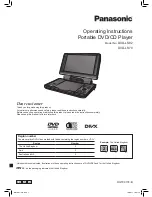
9
OPM-115
REV A
WARNING:
The electrolyte is diluted sulfuric acid that is harmful to the skin
and eyes. It is electrically conductive and corrosive. The following
precautions must always be taken.
1. Always wear full eye protection and protective clothing.
2. Where electrolyte contacts skin, wash off immediately with water.
3. If electrolyte contacts the eyes, flush thoroughly and immediately
with water and seek immediate medical attention
4. Spilled electrolyte is to be washed down with an acid neutralizing
agent. A common practice is to use a solution of one pound
of bicarbonate of soda (baking soda) to one gallon of water.
The bicarbonate of soda solution is to be added until the evidence
of reaction (foaming) has ceased. The resulting liquid is to be
flushed with water and the area dried.
DANGER: EXPLOSIVE FIRE RISK:
1. Never smoke when near batteries.
2. Do not cause a flame or spark in the battery area.
3. Always discharge static electricity from your body before touching
batteries by first touching a ground metal surface.
SERVICING BATTERIES
Batteries used on these units may, over time, lose water. This
is especially true if you are using a trickle charger to maintain
your battery. Different types of batteries require various types
of maintenance. Refer to the battery manufacturer for specific
recommendations.
NOTE:
Always make sure that a new battery is fully charged before
installing it on a generator set. Failure to do so can cause damage to
the engine control module in the generator set.
All connections must be clean and tight. Depending on your battery
type, check the electrolyte in the battery periodically to be sure it is
above the plates. Never allow the battery to remain in a discharged
condition.
CONNECTING BATTERY CHARGER & BLOCKHEATER
A three-stage battery charger is provided standard on this unit. The
charger is an Automatic Battery Charger & Maintainer. This charger
has three rates of charging. During the first mode, known as Bulk
charging, the charging current is limited to 10 Amps at a voltage of
up to 14/27 Volts. The yellow LED will be on constantly during this
stage. When the charging rate drops to 2.5 Amps, the charge will
enter the ABSORPTION charging mode. During this mode, the yellow
LED will be flashing. The charging voltage is held at 14/27 Volts and
the charging rate gradually reduces the amount of current (Amps)
flowing to the battery to 100% charged state. The battery can be left
on this mode indefinitely. During this mode, the green LED will be on
constantly.
This charger is mounted under the customer connection on the control
side of the generator and plugged into the receptacle mounted in
the AC connection cabinet. The battery charger receptacle is to be
powered by a GFCI circuit and installed in accordance with the United
States National Electric Code. It is suggested that this circuit be fused
for 15 amps. The blockheaters on these units are 1000 watt on the
DR175 and 2250 watt on the larger units. The 2250 watt heaters and
will require a separate 20 amp GFCI fused circuit. They are labeled
Battery Charger Circuit and Blockheater Circuit.
The engine blockheater installed on this unit should also be plugged
in this receptacle. The block heater is thermostatically controlled and
when plugged in will maintain the engine coolant temperature between
100 and 120 degrees F.
MOUNTING THE AUTOMATIC TRANSFER SWITCH
WARNING: FIRE HAZARD:
All wiring must be done by a licensed electrician, and must conform to
the National Electrical Code and comply with all the local codes and
regulations. Check with the local authorities before proceeding.
INSTALLATION NOTES:
Because of many different types of service, feeder and distribution
equipment, no specific wiring instructions can be provided. It is
recommended that only copper wire be used. In all cases it is
essential that while the load is connected to the generator, there can
be absolutely no feedback from the generator to the power line or the
power line to the generator. When properly installed, the normal ATS
Control and safety system will eliminate all paths and feedback.
To wire the automatic transfer switch into existing wiring, first determine
which circuits will be on the emergency load circuit. If the entire load is
transferred, the transfer switch can be wired directly after the watt-hour
meter and the service entrance, providing the service entrance ampere
rating is within the transfer switch’s rated capability.
If only specific circuits are to be powered under emergency power
failure conditions, an additional distribution panel designated
“emergency distribution panel” must be installed.
All selected emergency circuits are removed from main distribution
panels and installed in the emergency distribution panel. The ATS is
then installed between the main panel and the emergency distribution
panel. Suggested circuits: freezer, refrigerator, furnace, emergency
lights, sump pump, emergency outlet circuits, etc. Total running load
must not exceed generator rating.
Summary of Contents for DX100F4
Page 17: ...17 OPM 115 REV A SELECTOR SWITCH WIRING DIAGRAM DX90 DX130...
Page 18: ...18 OPM 115 REV A DX175...
Page 19: ...19 OPM 115 REV A DX250...
Page 20: ...20 OPM 115 REV A DX90F4 DX130F4 DSE 7310 MKII WIRING DIAGRAM...
Page 23: ...23 OPM 115 REV A ENGINE WIRING HARNESS DX90F4 DX130F4 DX175F4 DX350F4...










































